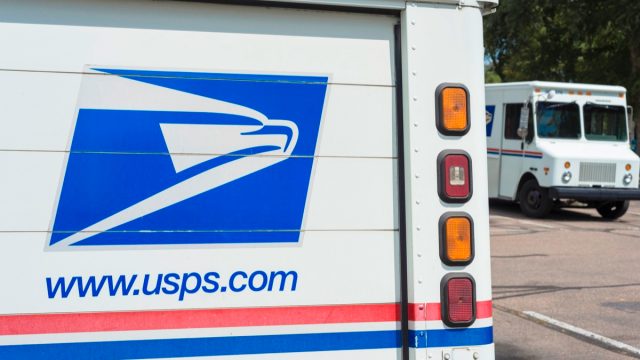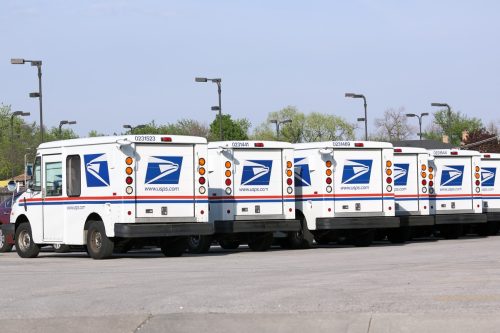USPS Is Now Delaying These Changes to Your Mail Delivery
The agency is postponing plans for a major transformation.

The U.S. Postal Service (USPS) seems to always be rolling out changes, and there's a good reason for that. As part of its Delivering for America (DFA) initiative, there have been a number of adjustments over the past couple years, including higher mail costs and slowed-down deliveries. But some USPS changes are more welcome, like the introduction of new courier trucks, which promise a major transformation for the agency. Now, however, the USPS is postponing the planned rollout of its upgraded vehicles, and with it, the changes these trucks were expected to bring. Read on to find out what's been pushed back till 2024.
READ THIS NEXT: USPS Is Making These New Changes to Your Mail, Starting May 19.
The USPS' new mail trucks promised changes to deliveries.

The Postal Service has been planning to freshen up its courier feet with tens of thousands of Next Generation Delivery Vehicles (NGDV).
"The USPS fleet has more than 230,000 vehicles in every class, including commercial-off-the-shelf vehicles," Albert Ruiz, a senior public relations representative for USPS, previously told Best Life. "Approximately 190,000 deliver mail six—and often seven—days a week in every U.S. community. The NGDV, along with other commercial vehicles, will replace and expand the current delivery fleet, which includes many vehicles that have been in service for over 30 years."
The NDGV are expected to bring about several new changes for our mail deliveries. The USPS noted that the upgraded trucks will feature a walk-in cargo area that will "maximize delivery efficiency," meaning you'd potentially get your mail faster. These trucks will also be battery-powered, making them more environmentally friendly, while also allowing them to run more quietly and require less maintenance.
It will also make things safer for carriers, pedestrians, and other drivers, as the NGV design includes "some of the most advance vehicle and safety technology" out there, according to Ruiz. This includes "360-degree cameras, advanced braking and traction control, airbags, a front-and rear-collision avoidance system that includes visual, audio warning, and automatic braking," he said.
Outside of upgrades to your delivery, the trucks will also bring about a welcome change for mail carriers: They feature air conditioning that will help keep carriers cool, comfortable, and safe enough to do their job without having to stop for potential heat-related illnesses.
The new trucks were expected this year.

The upgraded delivery trucks are meant to slowly replace the existing fleet over time. In December, the USPS announced that it is anticipating to receive at least 60,000 NGDVs by 2028. Of those, around 45,000 are expected to be battery electric.
"A key focus of our modernization effort is to reduce inefficient transportation and improve distribution operations, resulting in far less air cargo and far fewer truck trips," Postmaster General Louis DeJoy said in a statement at the time. "When combined with our substantial commitment to the electrification of our delivery vehicles, the Postal Service will be at the forefront of our nation's green initiatives."
The Postal Service has been working on this transformation since Feb. 2022, with the agency announcing its first purchase order of NGDV from manufacturer Oshkosh Defense in March of that year. These new vehicles from Oshkosh were expected to "start servicing postal routes in late 2023," the USPS said at the end of last year.
Now, that timeline has been pushed back.
RELATED: For more up-to-date information, sign up for our daily newsletter.
The agency is now delaying this rollout.

The Postal Service is postponing this year's plans for new courier trucks, Reuters reported.
The agency revealed on May 1 that its first set of next-generation delivery vehicles are no longer expected to come in until June 2024—which is nine months behind the original schedule, as it was planning to begin receiving deliveries from Oshkosh in Oct. 2023.
News of this delay was first disclosed in court filings from the U.S. District Court of California.
"The Postal Service now expects to receive the first such vehicles in June 2024 instead of Oct. 2023, as previously projected," the document filed on May 1 states.
The USPS has been battling officials over its commitment to electric vehicles.

The delay is tied to the backlash the Postal Service has experienced since the details of its plans were released. When the USPS first announced its contract with Oshkosh, it was revealed that just 10 percent of its initial order was expected to be battery electric vehicles (BEVs), eSeller365 reported.
Despite the agency's decision to double the size of its BEVs in March 2022, 16 states and several environment groups filed a lawsuit against the USPS the next month over its NGDVs. Officials claimed the agency failed "to follow a process mandated by the National Environmental Policy Act (NEPA)" by choosing to replace its fleet with mostly gas-powered versions of the NGDV.
As a result of the suit, the Postal Service agreed to make sure at least half of all of its NGDVs are BEVs. But before the agency can accept delivery of its new electric vehicles, it must finalize its Supplemental Environmental Impact Statement (SEIS), according to eSeller365.
A draft of this report was originally expected to be released this month, with the final version expected for Aug. 2023. But the SEIS has been delayed, as the Postal Service said it has had to "undertake revisions of several aspects of its environmental analysis," per court filings.
Now, the rollout has been delayed—and with it, the highly-anticipated changes to mail delivery.





















